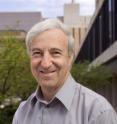Cornell astrophysicists play vital role to validate detection of gravitational waves
Cornell physics and astrophysics professor Saul Teukolsky has been using supercomputers to solve Einstein's equations for black hole mergers for much of his career. Teukolsky and the Cornell-founded Simulation of eXtreme Spacetimes (SXS) collaboration group have been calculating and completing a full catalog of theoretical solutions since 2000, when supercomputers first became capable of the task. The LIGO (Laser Interferometer Gravitational-Wave Observatory) and Virgo group confirmed that the waves came from a black hole merger by comparing their data with a theoretical model developed at Cornell.
Teukolsky says:
"The LIGO announcement describes one of the greatest scientific discoveries of the past 50 years. Gravitational waves have been a theoretical prediction of Einstein's general theory of relativity for the past 100 years.
"Our group has been solving Einstein's equations on supercomputers to predict the precise form of the signal that should be seen. Our theoretical predictions lie right on top of the experimentalist's measurements - an exciting confirmation of general relativity.
"Finally these waves have been detected on Earth with an unbelievably sensitive experiment. And, surprisingly, the source of the waves is a system of two black holes in orbit around each other, that spiral inward and smash together."
Source: Cornell University
Articles on the same topic
- GGC physicist leads team in innovative black hole researchFri, 12 Feb 2016, 13:47:50 UTC
- LIGO confirms RIT's breakthrough prediction of gravitational wavesFri, 12 Feb 2016, 13:47:43 UTC
Other sources
- When black holes meet—inside the cataclysms that cause gravitational wavesfrom PhysorgFri, 12 Feb 2016, 13:40:42 UTC
- Hear 2 Black Holes Merging in This Unforgettable Sound Clipfrom Live ScienceThu, 11 Feb 2016, 20:41:20 UTC
- Stunning New Image Shows Gravitational Waves As Two Black Holes Mergefrom Live ScienceThu, 11 Feb 2016, 20:11:29 UTC
- GGC physicist leads team in innovative black hole researchfrom PhysorgThu, 11 Feb 2016, 17:52:05 UTC
- LIGO detects first ever gravitational waves – from two merging black holesfrom Physics WorldThu, 11 Feb 2016, 17:10:48 UTC
- Historic Gravitational Waves Discovery Explained By Experts | Videofrom Live ScienceThu, 11 Feb 2016, 16:40:24 UTC
- Historic Gravitational Waves Discovery Explained By Experts | Videofrom Space.comThu, 11 Feb 2016, 16:20:51 UTC
